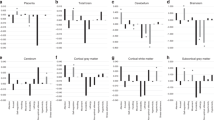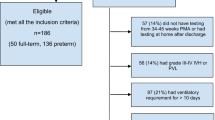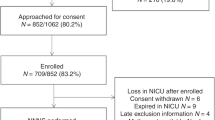Abstract
Objective
To examine the relationship between maternal pre-pregnancy body mass index (BMI) and neonatal neurobehavior in very premature infants.
Study design
Multi-center prospective observational study of 664 very preterm infants with 227 born to obese mothers. The NICU Network Neurobehavioral Scale (NNNS) assessed neurobehavior at NICU discharge.
Results
Elevated BMI combined with infection increased the odds of having the most poorly regulated NNNS profile by 1.9 times per BMI SD. Infants born to mothers with elevated BMI in combination with: infection had poorer self-regulation, chorioamnionitis had increased asymmetrical reflexes, diabetes had poorer attention, and low SES required more handling.
Conclusion
Maternal pre-pregnancy BMI alone did not affect short-term neonatal neurobehavior in infants born before 30 weeks gestation. Infants born to mothers with elevated pre-pregnancy weight in addition to infections, diabetes, or socioeconomic adversity demonstrated increased risk of having the most poorly regulated NNNS profile and deficits in multiple domains.
This is a preview of subscription content, access via your institution
Access options
Subscribe to this journal
Receive 12 print issues and online access
$259.00 per year
only $21.58 per issue
Buy this article
- Purchase on Springer Link
- Instant access to full article PDF
Prices may be subject to local taxes which are calculated during checkout


Similar content being viewed by others
References
Huda SS, Brodie LE, Sattar N. Obesity in pregnancy: prevalence and metabolic consequences. Semin Fetal Neonatal Med. 2010;15:70–6.
Baeten JM, Bukusi EA, Lambe M. Pregnancy complications and outcomes among overweight and obese nulliparous women. Am J Public Health. 2001;91:436–40.
Cogswell ME, Perry GS, Schieve LA, Dietz WH. Obesity in women of childbearing age: risks, prevention, and treatment. Prim Care Update Ob/Gyns. 2001;8:89–105.
Hinkle SN, Schieve LA, Stein AD, Swan DW, Ramakrishnan U, Sharma AJ. Associations between maternal prepregnancy body mass index and child neurodevelopment at 2 years of age. Int J Obes. 2012;36:1312–9.
Van Lieshout RJ, Taylor VH, Boyle MH. Pre-pregnancy and pregnancy obesity and neurodevelopmental outcomes in offspring: a systematic review. Obes Rev. 2011;12:e548–e559.
Rodriguez A, Miettunen J, Henricksen TB, Olsen J, Obel C, Taanila A, et al. Maternal adiposity prior to pregnancy is associated with ADHD symptoms in offspring: evidence from three prospective pregnancy cohorts. Int J Obes. 2008;32:550–7.
Denison FC, Roberts KA, Barr SM, Norman JE. Obesity, pregnancy, inflammation and vascular function. Reproduction 2010;140:373–85.
Saben J, Lindsey F, Zhong Y, Thakali K, Badger TM, Andres A, et al. Maternal obesity is associated with a lipotoxic placental environment. Placenta 2014;35:171–7.
Heerwagen MJR, Miller MR, Barbour LA, Friedman JE. Maternal obesity and fetal metabolic programming: a fertile epigenetic soil. Am J Physiol Regul Integr Comp Physiol. 2010;299:R711–R722.
Aubuchon-Endsley N, Morales M, Giudice C, Bublitz MH, Lester BM, Salisbury AL, et al. Maternal pre-pregnancy obesity and gestational weight gain influence neonatal neurobehavior. Matern Child Nutr. 2017;13:1–12.
Helderman JB, O’Shea TM, Kuban KCK, Allred EN, Hecht JL, Dammann O, et al. Antenatal antecedents of cognitive impairment at 24 months in extremely low gestational age newborns. Pediatrics 2012;129:494–502.
Stephens BE, Vohr BR. Neurodevelopmental outcome of the premature infant. Pediatr Clin North Am. 2009;56:631–46.
Liu J, Bann C, Lester B, Tronick E, Das A, Lagasse L, et al. Neonatal neurobehavior predicts medical and behavioral outcome. Pediatrics 2010;125:e90–98.
Lester BM, Bagner DM, Liu J, LaGlasse LL, Seifer R, Bauer CR, et al. Infant neurobehavioral dysregulation: behavior problems in children with prenatal substance exposure. Pediatrics 2009;124:1355–62.
Lester BM, Andreozzi-Fontaine L, Tronick E, Bigsby R. Assessment and evaluation of the high risk neonate: the NICU Network Neurobehavioral Scale. J Vis Exp. 2014;90:e3368.
Lester BM, Tronick EZ. The NICU Network Neurobehavioral Scale (NNNS). Pediatrics (Suppl). 2004;113:631–99.
McGowan EC, Hofheimer JA, O’Shea TM, Carter BS, Helderman J, Neal CR, et al. Sociodemographic and Medical Influences on Neurobehavioral Patterns in Preterm Infants: A Multi-Center Study. Early Hum Dev. 2020;142:1–18.
Brown NC, Doyle LW, Bear MJ, Inder TE. Alterations in neurobehavior at term reflect differing perinatal exposures in very preterm infants. Pediatrics. 2006;118:2461–71.
Everson TM, Marsit CJ, O’Shea TM, Burt A, Hermetz K, LaGasse LL, et al. Epigenome-wide analysis identifies genes and pathways linked to neurobehavioral variation in preterm infants. Sci Rep. 2019;9:6322.
Hofheimer JA, Smith LM, McGowan EC, O’Shea TM, Carter BS, Neal CR, et al. Psychosocial and medical adversity associated with neonatal neurobehavior in infants born before 30 weeks gestation. Pediatr Res. 2019;87:721–9.
McElrath TF, Hecht JL, Dammann O, Boggess K, Onderdonk A, Markenson G, et al. Pregnancy disorders that lead to delivery before the 28th week of gestation: an epidemiologic approach to classification. Am J Epidemiol. 2008;168:980–9.
Walden RV, Taylor SC, Hansen NE, Poole WK, Stoll BJ, Abuelo D, et al. Major congenital anomalies place extremely low birth weight infants at higher risk for poor growth and developmental outcomes. Pediatrics 2007;120:e1512–e1519.
Hollingshead AB. Four Factor Index of Social Status. New Haven, CT:Yale Univ.;1975.
Kuban K, Adler I, Allred EN, Batton D, Bezinque S, Betz BW, et al. Observer variability assessing US scans of the preterm brain: the ELGAN study. Pediatr Radio. 2007;37:1201–8.
Tronick EZ, Olson K, Rosenberg R, Bohne L, Lu J, Lester BM. Normative neurobehavioral performance of healthy infants on the Neonatal Intensive Care Unit Network Neurobehavioral Scale. Pediatrics 2004;113:676–8.
van der Burg JW, Jensen ET, van de Bor M, Joseph RM, O’Shea TM, Kuban K, et al. Maternal obesity and attention-related symptoms in the preterm offspring. Early Hum Dev. 2017;115:9–15.
Jensen ET, van der Burg JW, O’Shea TM, Joseph RM, Allred EN, Heeren T, et al. The relationship of maternal prepregnancy body mass index and pregnancy weight gain to neurocognitive function at age 10 years among children born extremely preterm. J Pediatr. 2017;187:50–57.e3.
Appleton AA, Murphy MA, Koestler DC, Lesseur C, Paquette AG, Padbury JF, et al. Prenatal programming of infant neurobehaviour in a healthy population. Paediatr Perinat Epidemiol. 2016;30:367–75.
Rosenberg TG, Garbers S, Lipkind H, Chiasson MA. Maternal obesity and diabetes as risk factors for adverse pregnancy outcomes: differences among 4 racial/ethnic groups. Am J Public Health. 2005;95:1545–51.
Catalano PM, McIntyre HD, Cruickshank JK, McCance DR, Dyer AR, Metzger BE, et al. The hyperglycemia and adverse pregnancy outcome study: associations of GDM and obesity with pregnancy outcomes. Diabetes Care. 2012;35:780–6.
Ornoy A, Reece EA, Pavlinkova G, Kappen C, Miller RK. Effect of maternal diabetes on the embryo, fetus, and children: congenital anomalies, genetic and epigenetic changes and developmental outcomes. Birth Defects Res C. 2015;105:53–72.
Casson IF, Clarke CA, Howard CV, McKendrick O, Penncycook S, Pharoah PO, et al. Outcomes of pregnancy in insulin dependent diabetic women: results of a five year population cohort study. BMJ 1997;315:275–8.
Rizzo T, Metzger BE, Burns WJ, Burns K. Correlations between antepartum maternal metabolism and child intelligence. N Engl J Med. 1991;325:911–6.
Sells CJ, Robinson NM, Brown Z, Knopp RH. Long-term developmental follow-up of infants of diabetic mothers. J Pediatr. 1994;125:S9–S17.
Biessels GJ, Gispen WH. The impact of diabetes on cognition: what can be learned from rodent models? Neurobiol Aging. 2005;26:36–41.
Chu SY, Callaghan WM, Kim SY, Schmid CH, Lau J, England LJ, et al. Maternal obesity and risk of gestational diabetes mellitus. Diabetes Care. 2007;30:2070–6.
Hendson L, Russell L, Robertson CMT, Liang Y, Chen Y, Abdalla A, et al. Neonatal and neurodevelopmental outcomes of very low birth weight infants with histologic chorioamnionitis. J Pediatr. 2011;158:397–402.
Soraisham AS, Trevenen C, Wood S, Singhal N, Sauve R. Histological chorioamnionitis and neurodevelopmental outcome in preterm infants. J Perinatol. 2013;30:70–5.
Adler NE, Rehkopf DF. US disparities in health: descriptions, causes, and mechanisms. Annu Rev Public Health. 2008;29:235–52.
Bradley RH, Corwyn RF. Socioeconomic status and child development. Annu Rev Psychol. 2002;53:371–99.
Brooks-Gunn J, Duncan GJ. The effects of poverty on children. Future Child. 1997;7:55–71.
Spencer N, Bambang S, Logans S, Gill L. Socioeconomic status and birth weight: comparison of an area-based measure with the Registrar General’s social class. J Epidemiol Community Health. 1999;53:495–8.
Bohnert KM, Breslau N. Stability of psychiatric outcomes of low birth weight: a longitudinal investigation. Arch Gen Psychiatry. 2008;65:1080–6.
Strauss RS. Adult functional outcome of those born small for gestational age: twenty-six-year follow-up of the 1970 British Birth Cohort. JAMA 2000;283:625–32.
Schlotz W, Phillips DIW. Fetal origins of mental health: evidence and mechanisms. Brain Behav Immun. 2009;23:905–16.
Hackman DA, Farah MJ, Meaney MJ. Socioeconomic status and the brain: mechanistic insights from human and animal research. Nat Rev Neurosci. 2010;11:651–9.
Frazier JA, Wood ME, Ware J, Joseph RM, Kuban KC, O’Shea TM, et al. Antecedents of the child behavior checklist-dysregulation profile in children born extremely preterm. J Am Acad Child Adolesc Psychiatry. 2015;54:816–23.
Joseph RM, O’Shea TM, Allred EN, Heeren T, Kuban KK. Maternal education status at birth, maternal educational advancement, and neurocognitive outcomes at age 10 years among children born extremely preterm. Pediatr Res. 2017;83:767–77.
Peralta-Carcelen M, Carlo WA, Pappas A, Vaucher YE, Yeates KO, Phillips VA, et al. Behavioral problems and socioemotional competence at 18 to 22 months of extremely premature children. Pediatrics 2017;139:e20161043.
Chen YH, Li L, Chen W, Liu ZB, Ma L, Gao XX, et al. Pre-pregnancy underweight and obesity are positively associated with small-for-gestational-age infants in a Chinese population. Sci Rep. 2019;9:15544–54.
Hinkle SN, Schieve LA, Swan DW, Ramakrishnan U, Sharma AJ. Associations between maternal prepregnancy body mass index and child neurodevelopment at 2 years of age. Int J Obes. 2012;36:1312–9.
Funding
Funded by National Institutes of Health (NIH)/Eunice Kennedy Shriver. National Institute of Child Health and Human Development (NICHD) grant R01HD072267.
Author information
Authors and Affiliations
Contributions
NPN was responsible for the conceptualization, investigation, and resources of the paper as well as the drafting and editing of the paper. LMS was responsible for the conceptualization, data curation, investigation, and supervision of the paper along with the drafting and editing of the paper. LMD and MBR were responsible for the methodology, data curation, formal analysis, and resources of the paper as well as the drafting and editing of the paper. JAH was responsible for the conceptualization, methodology, investigation, supervision, funding acquisition, data curation, and resources of the paper along with the drafting and editing of the paper. BSC, JBH, ECM, CRN, and SP were responsible for the methodology, investigation, and resources of the paper along with the editing of the paper. SADG was responsible for the methodology, investigation, data curation, and resources of the paper along with the editing of the paper. MO’S and BML were responsible for the conceptualization, methodology, investigation, supervision, funding acquisition, data curation, and resources of the paper along with the drafting and editing of the paper.
Corresponding author
Ethics declarations
Competing interests
The authors declare no competing interests.
Additional information
Publisher’s note Springer Nature remains neutral with regard to jurisdictional claims in published maps and institutional affiliations.
Rights and permissions
About this article
Cite this article
Nosavan, N.P., Smith, L.M., Dansereau, L.M. et al. Associations between maternal pre-pregnancy body mass index and neonatal neurobehavior in infants born before 30 weeks gestation. J Perinatol 42, 483–490 (2022). https://doi.org/10.1038/s41372-021-01308-y
Received:
Revised:
Accepted:
Published:
Issue Date:
DOI: https://doi.org/10.1038/s41372-021-01308-y



